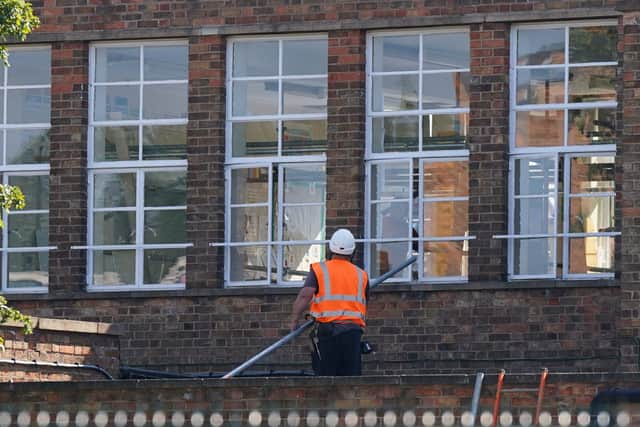Schools concrete: government could be liable over reliance on self-reporting of RAAC, says lawyer
and live on Freeview channel 276
The government could be found liable in the RAAC scandal over its reliance on schools self-reporting the prescence of the “prone to collapse” concrete, a lawyer has said.
Last Friday (1 September), more than 100 schools were told to fully or partially close as a result of concerns over “crumbly” concrete - and the possibility that buildings and facilities could collapse on children. Ministers contacted these schools following responses to a questionnaire sent out in March 2022, which targeted schools with buildings constructed between 1930 and 1990 - when RAAC (reinforced autoclaved aerated concrete) was a popular material.
Advertisement
Hide AdAdvertisement
Hide AdHowever, on Monday (4 September), Prime Minister Rishi Sunak admitted that “hundreds more” schools could also be affected by the crisis - as not all questionnaire responses had been received. “While we are still waiting on schools to return their surveys and confirm their specific situations, we can’t be more definitive,” he said.
Meanwhile, Phil Caton, a construction law partner at top legal firm Aaron & Partners, has told NationalWorld that the government could face some legal responsibility over its handling of RAAC. He explained that if a court was considering liabilities, it would need to scrutinise both ministers’ knowledge of the risks associated with the “crumbly” concrete - as well as the adequacy of their response when concerns were raised about schools.
The most pressing issue here, he said, would be the fact that the Department for Education (DfE) has “relied on” schools self-reporting RAAC, without a “clear, immediate verification process by the DfE”. This, he argued, “leaves room for considerable gaps in data”, and, as a result, delays in the implementation of health and safety measures.
This becomes clear in figures from the National Audit Office (NAO) on the responses to a March 2022 questionnaire the DfE sent to schools with buildings constructed between 1930 and 1990. According to the NAO, 86% of targeted schools responded - but just 42%, or around 6,300 schools, reported they had taken steps to identify RAAC.
Advertisement
Hide AdAdvertisement
Hide Ad“That leaves a troubling 58%, or around 8,600 schools, that either did not respond, had not completed the necessary work, or were unaware of RAAC-related risks,” Mr Caton said. “Parents are therefore left in the dark about whether their children’s schools are genuinely safe - or whether they were even inspected [in the first place].”


Speaking to broadcasters on Monday (4 September), education secretary Gillian Keegan argued that the DfE is going “over and above” what it needs to do as she insisted that local authorities and multi-academy trusts are the bodies “responsible” for making sure buildings do not collapse.
She said that student safety is the government’s “priority”, but sought to reassure parents by saying that the government expects the number of schools affected “to be in the hundreds, not thousands”. This still means thousands of children are potentially at risk, however.
Keegan also responded to criticism over the delay in publishing the full list of schools affected, explaining that ministers want schools to have had a chance to contact parents first. Mr Caton however called this approach “unsettling” for parents and students alike.
Advertisement
Hide AdAdvertisement
Hide Ad“In the absence of any transparent data from the DfE, parents may well consider writing to their schools to seek confirmation as to whether this crucial questionnaire about the presence of RAAC in their buildings has been completed," he contined.
Ministers have also been questioned over the past few days about why an announcement about RAAC was left until just before the start of the new school year.
The schools minister Nick Gibbs claimed last week that the issue had only fully “emerged over the summer”, but NationalWorld reported on Friday (1 September) that the DfE’s own risk assessment of the likelihood of buildings collapsing had been upgraded from ““crisis - likely” to “critical - very likely” back in September 2021.
Meanwhile, a report in June by the NAO said that the risk of injury or death from a school building collapse in England was still “very likely” - as it warned of the “critical” danger to pupils and staff.
Advertisement
Hide AdAdvertisement
Hide AdElsewhere, in terms of other bodies possibly facing legal woes over RAAC, Mr Caton said that the liabilities “could be substantial”. He explained that schools, councils, and past contractors could all be “implicated in a series of complex legal disputes over responsibility for failures or incidents” - but that one issue is the fact that, given RAAC was popular between the 1950s and mid-1990s, many of the contractors who were initially involved may no longer exist.
“This adds complexity to an already challenging situation involving public safety concerns,” he remarked, “[which is why] there is an urgent need for a transparent and coordinated approach among government bodies, schools, and construction experts to manage both the immediate safety risks and the long-term legal implications of this matter.”
Comment Guidelines
National World encourages reader discussion on our stories. User feedback, insights and back-and-forth exchanges add a rich layer of context to reporting. Please review our Community Guidelines before commenting.
